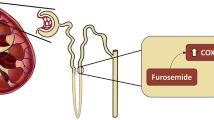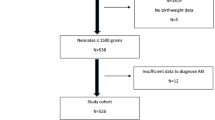Abstract
Background and aim: A patent ductus arteriosus (PDA) may influence renal and hepatic blood flow and hence pharmacokinetics of drugs in neonates compared to neonates with a closed ductus arteriosus (CDA). A 10‐percent difference of gentamicin pharmacokinetic parameters between PDA and CDA has been reported, but its implications are unclear. The relevance of this difference relative to the variability within the neonatal population was investigated.
Methods: Twenty‐four neonates (12 with a PDA and 12 with a CDA) treated with gentamicin were retrospectively included. Before closing treatment of the PDA, serum levels were drawn and analysed for regular therapeutic drug monitoring of gentamicin. Data were analysed using the standard two‐stage approach (STS) and an iterative 2‐stage Bayesian population analysis approach (It2B).
Results: Both types of analysis showed no significant differences between both populations for gentamicin total body clearance per kg bodyweight (CL/kg). Volume of distribution per kg bodyweight (Vd/kg) tended to be larger and elimination rate (Kel) tended to be smaller in neonates with PDA. Multiple regression analysis showed for both populations highly significant correlations between total body clearance and body weight (p<0.0001) or gestational age (p<0.0001), and between volume of distribution and body weight (p<0.0001) or gestational age (p<0.0001).
Conclusion: Although neonates with a PDA may have small differences in gentamicin pharmacokinetics compared to neonates with a CDA, this is not relevant for clinical practice taking the variability within that population into account.
Similar content being viewed by others
References
Van den Anker JN. Pharmacokinetics and renal function in preterm infants. Acta Paediatr 1996; 85: 1393-1399.
Gal P, Gilman JT. Drug disposition in neonates with patent ductus arteriosus. Ann Pharmacother 1993; 27: 1383-1388.
Dodge WF, Jelliffe RW, Richardson CJ, McCleery RA, Hokanson JA, Snodgrass WR. Gentamicin population pharmacokinetic models for low birth weight infants using a new nonparametric method. Clin Pharmacol Ther 1991; 50: 25-31.
Jensen PD, Edgren BE, Brundage RC. Population pharmacokinetics of gentamicin in neonates using a nonlinear, mixedeffects model. Pharmacotherapy 1992; 12: 178-182.
Izquierdo M, Lanao JM, Cervero L, Jimenez NV, Dominguez-Gil A. Population pharmacokinetics of gentamicin in premature infants. Ther Drug Monit 1992; 14: 177-183.
Weber W, Kewitz G, Rost KL, Looby M, Nitz M, Harnisch L. Population kinetics of gentamicin in neonates. Eur J Clin Pharmacol 1993; 44(suppl 1): S23-S25.
De Hoog M, Schoemaker RC, Mouton JW, Van den Anker JN. Tobramycin population pharmacokinetics in neonates. Clin Pharmacol Ther 1997; 62: 392-399.
Vervelde ML, Rademaker CMA, Krediet TG, Fleer A, Van Asten P, Van Dijk A. Population pharmacokinetics of gentamicin in preterm neonates: Evaluation of a once-daily dosage regimen. Ther Drug Monit 1999; 21:514-519.
Williams BS, Ransom JL, Gal P, Carlos RQ, Smith M, Schall SA. Gentamicin pharmacokinetics in neonates with patent ductus arteriosus. Crit Care Med 1997; 25: 273-275.
Van den Anker J, Kearns GL. Gentamicin pharmacokinetics in neonates with patent ductus arteriosus. Crit Care Med 1997; 25: 1933-1934.
Touw DJ, Vinks AATMM, Neef C. Pharmacokinetic modelling of intravenous tobramycin in adolescent and adult patients with cystic fibrosis using the Nonparametric Expectation Maximization (NPEM) algorithm. Pharm World Sci 1997; 19: 142-151.
Proost JH, Meijer DKF. MW\Pharm, an integrated software package for drug dosage regimen calculation and therapeutic drug monitoring. Comput Biol Med 1992; 22: 155-163.
Steimer JL, Mallet A, Golmard JL, Boisvieux JF. Alternative approaches to estimation of population pharmacokinetic parameters: comparison with the nonlinear mixed-effect model. Drug Metab Rev 1984; 15: 265-292.
Bennett JE, Wakefield JC. A comparison of a Bayesian population method with two methods as implemented in commercially available software. J Pharmacokinet Biopharm 1996; 24: 403-432.
Kaspers GJL, Teunissen PC, Holl H. Administration of gentamicin to newborn: once daily. Ned Tijdschr Geneeskd 1998; 142: 583-585.
Eitelberger F, Hohenhauer L, Sommer R. Dosage and dosage interval of tobramycin in the newborn. Br J Clin Pract 1988; 42(suppl 57): 49-53.
Lafeber HN. Nutritional assessment and measurement of body composition in preterm infants. Clinics in Perinatology 1999; 26: 997-1005.
Author information
Authors and Affiliations
Rights and permissions
About this article
Cite this article
Touw, D., Proost, J., Lafeber, R. et al. Gentamicin pharmacokinetics in preterm infants with a patent and a closed ductus arteriosus. Pharm World Sci 23, 200–204 (2001). https://doi.org/10.1023/A:1012490704731
Issue Date:
DOI: https://doi.org/10.1023/A:1012490704731




